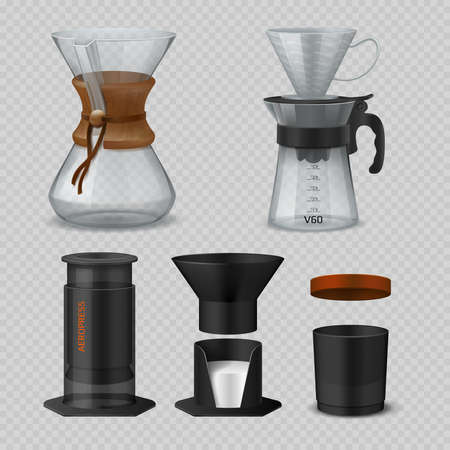1. Why Commercial-Grade Grinders Matter
Whether youre running a cozy neighborhood café or crafting espresso shots at home like a pro, the coffee grinder you use plays a huge role in the quality of your brew. While consumer grinders may seem convenient and affordable, they often fall short when it comes to consistency, durability, and performance—especially under frequent use. Heres why stepping up to a commercial-grade coffee grinder can make all the difference for small U.S. cafés and serious home baristas.
The Key Differences Between Consumer and Commercial-Grade Grinders
At first glance, all grinders might look similar, but theres a big gap in what they deliver. Commercial-grade grinders are built for heavy-duty use, precision grinding, and long-term reliability. Let’s break down the main differences:
| Feature | Consumer Grinders | Commercial-Grade Grinders |
|---|---|---|
| Grind Consistency | Inconsistent particle size | Uniform grind for better flavor extraction |
| Burr Size & Quality | Smaller burrs, often lower quality materials | Larger, precision-engineered burrs made from hardened steel or ceramic |
| Motor Power | Weaker motors not suited for high volume | Powerful motors designed for continuous use |
| Durability | Suits occasional use; wears out faster | Built to last with robust components |
| Speed & Efficiency | Slower grind time, more clumping | Fast grinding with reduced heat buildup |
Why It Matters for Small Cafés and Home Enthusiasts
If youre serving multiple customers each day or pulling several shots at home, inconsistency in grind size can seriously affect taste. A commercial-grade grinder ensures that each shot of espresso or pour-over cup extracts the right balance of flavors every time. This kind of reliability is especially important for cafés aiming to build customer trust—and for passionate home brewers who want to replicate café-quality drinks.
Better Taste Starts with Better Grinding
Coffee brewing is all about extraction. When your grind size is uneven, some particles over-extract (bitter), while others under-extract (sour). A commercial-grade grinder minimizes these issues by delivering consistent grinds every time—helping you hit that sweet spot of flavor.
A Smart Long-Term Investment
While commercial grinders come at a higher upfront cost, they tend to outlast consumer models by years. For small business owners and committed home baristas alike, that means fewer replacements, less downtime, and better coffee—day after day.
2. Top Features to Look For
When choosing a commercial-grade coffee grinder for your small café or serious home setup, it’s important to know what features truly matter. The right grinder can make a noticeable difference in the flavor, consistency, and efficiency of your coffee-making process. Here are the key features to keep an eye on:
Burr Type: Flat vs. Conical
Burrs are the heart of any quality grinder. They crush coffee beans into uniform particles, which is essential for consistent extraction. There are two main types of burrs you’ll encounter—flat and conical.
| Burr Type | Pros | Cons |
|---|---|---|
| Flat Burrs | High grind consistency, better for espresso, usually faster grinding | Louder operation, may retain more grounds |
| Conical Burrs | Quieter, less heat buildup, more forgiving with grind size | Slightly less consistent than flat burrs at very fine settings |
Grind Size Adjustability
If you’re brewing a variety of drinks—from espresso to pour-over—you’ll need a grinder that offers precise grind size control. Commercial-grade grinders typically come with either stepped or stepless adjustment systems:
Stepped Adjustment
This system has predefined settings that click into place, making it easy to switch between brew styles quickly—great for beginners or cafés serving different brew types throughout the day.
Stepless Adjustment
This system offers infinite control over grind size within a range. It’s perfect for dialing in espresso shots but takes more time and experience to master.
Motor Power and Speed
A strong motor ensures consistent performance during busy hours or back-to-back brewing sessions at home. Look for grinders with motors rated around 250–500 watts for commercial use or high-end home use. Higher wattage generally means faster grinding and better handling of dense beans.
Pro Tip:
A lower RPM (revolutions per minute) motor helps reduce heat buildup, which can affect flavor by prematurely extracting oils from the beans.
Durability and Build Quality
Coffee grinders made with high-quality materials like stainless steel or heavy-duty aluminum will last longer and perform more consistently. Look for models designed with commercial environments in mind—theyre built to handle frequent use without wearing down quickly.
- Metal casing: More durable than plastic and better at dissipating heat.
- Commercial-grade burrs: Typically last thousands of pounds of coffee before needing replacement.
- Easy maintenance: Models that allow quick access to burrs for cleaning help maintain consistent performance over time.
Choosing a grinder with these top features ensures youre investing in equipment that delivers both reliability and great-tasting coffee—whether youre running a neighborhood café or just aiming for barista-level brews at home.

3. Best Grinders for Small Cafés
Running a small café in the U.S. means every square foot counts, and so does every shot of espresso. You need a grinder that’s compact but powerful—something that can handle a steady morning rush without compromising on quality. Here’s a curated list of commercial-grade coffee grinders that are ideal for small spaces while still delivering café-level consistency and performance.
Top Picks for Space-Saving Commercial Grinders
The following grinders are known for their reliability, precision, and space-conscious design—perfect for smaller coffee shops or espresso bars with limited counter space.
| Grinder Model | Best For | Burr Type | Dimensions (W x D x H) | Why It Works for Small Cafés |
|---|---|---|---|---|
| Mazzer Mini Electronic | Espresso-focused cafés | Flat Burrs (64mm) | 7 x 13.5 x 16.5 in | Compact footprint with commercial-grade durability; programmable dosing helps speed up service |
| Baratza Forte BG | Pourover & batch brew shops | Flat Steel Burrs (54mm) | 5 x 5 x 14 in | Precise grind settings with weight-based dosing; great for drip and manual brewing methods |
| Eureka Atom Specialty 65 | Cafés needing quiet operation | Flat Burrs (65mm) | 7 x 10 x 17 in | Sleek design, low noise output, and fast grinding speeds make it great for open counter environments |
| Anfim Scody II | Cafés with moderate espresso volume | Flat Burrs (75mm) | 8 x 11 x 22 in | Larger burrs offer faster grinding and excellent consistency; built to handle busy mornings |
What to Look For in a Café Grinder
If you’re running a neighborhood coffee spot or a mobile espresso bar, here are some features to prioritize:
- Dose Consistency: Look for electronic dosing or weight-based options to reduce waste and improve workflow.
- Burr Size & Type: Flat burrs generally provide more uniform particle size, which helps with flavor clarity—important if you serve high-quality beans.
- Noiseless Operation: Some grinders are designed with sound insulation, which is ideal if you have an open kitchen or quiet setting.
- User-Friendly Interface: Digital displays and easy grind adjustments can save time during peak hours.
A Smart Investment for Quality and Efficiency
A good grinder is just as important as your espresso machine. Investing in the right one not only improves the taste of your drinks but also speeds up service and minimizes waste. These recommended models strike a balance between size, power, and performance—tailored for small U.S.-based cafés aiming to deliver top-tier coffee experiences.
4. Ideal Options for Home Baristas
If youre a dedicated home barista in the U.S. looking to bring café-quality coffee into your kitchen, youre not alone. More and more coffee lovers are investing in commercial-grade grinders that deliver precision and consistency without taking up too much space. Luckily, there are prosumer and under-counter models made exactly for this purpose.
What Makes a Grinder “Prosumer”?
Prosumer (professional + consumer) grinders bridge the gap between home appliances and commercial equipment. They offer high-end features like stepless grind adjustment, powerful motors, and burr sets found in professional cafés—but in a footprint thats manageable for most home kitchens.
Why Under-Counter Models Matter
Space is often limited in American homes, especially in urban areas. Under-counter grinders are designed to fit seamlessly into your kitchen layout without sacrificing performance. These models usually have lower profiles or modular designs that help save counter space while still offering commercial-grade power and precision.
Top Features Home Baristas Should Look For
- Burr Type: Flat or conical burrs made of hardened steel or ceramic for durability and consistency.
- Grind Adjustment: Stepless or micro-adjustment capabilities for dialing in espresso shots precisely.
- Dose Control: Programmable dosing by time or weight to reduce waste and improve consistency.
- Build Quality: Sturdy metal housing and commercial-grade components ensure long-lasting performance.
- Size & Layout: Compact or under-counter-friendly design to fit modern U.S. kitchens.
Recommended Commercial-Grade Grinders for Serious Home Use
| Model | Key Features | Why It’s Great for Home Baristas |
|---|---|---|
| Eureka Mignon Specialita | 55mm flat burrs, stepless micrometric adjustment, quiet operation | Compact size with pro-level grind control—perfect for espresso lovers with limited counter space |
| Mazzer Mini Electronic | 64mm flat burrs, programmable dosing, heavy-duty build | A true commercial grinder scaled down just enough for serious home use |
| Niche Zero | 63mm conical burrs, single-dose design, low retention | Excellent for those who brew multiple styles of coffee at home and want zero grind waste |
| Baratza Forte AP | Ceramic flat burrs, built-in scale, touch screen controls | A prosumer powerhouse with grind-by-weight capability and small footprint |
Tips for Choosing the Right Grinder at Home
Your choice depends on your brewing method (espresso vs. pour-over), available space, and how often you make coffee. If you’re an espresso enthusiast who pulls several shots daily, investing in a grinder like the Mazzer Mini or Eureka Specialita will pay off in quality and consistency. If you enjoy switching between brew methods or value minimal retention, consider a single-dose model like the Niche Zero.
Pro Tip:
Make sure your grinder fits under your cabinets! Measure your available height before purchasing any commercial-grade model to avoid surprises once it arrives.
No matter which grinder you choose, upgrading to a prosumer-level machine is one of the best ways to elevate your home coffee game to café standards—all while keeping your kitchen stylish and functional.
5. Maintenance and Longevity Tips
Taking care of your commercial-grade coffee grinder isn’t just about keeping it clean—it’s about protecting your investment and ensuring every shot of espresso or brewed coffee tastes just right. Whether youre running a cozy café in Portland or dialing in your grind from a San Diego kitchen, a little maintenance goes a long way.
Why Regular Maintenance Matters
Commercial grinders are built tough, but they still need regular attention to stay in peak condition. Over time, coffee oils, fine particles, and daily wear can affect performance. Without proper upkeep, you might experience inconsistent grind sizes, slower grinding speeds, or even motor issues.
Cleaning Your Grinder
Routine cleaning is key to preventing buildup and preserving flavor clarity. Heres a simple guide to keep things fresh:
| Cleaning Task | Frequency | Tools/Products Needed |
|---|---|---|
| Wipe exterior & hopper | Daily | Damp cloth, mild soap if needed |
| Remove & clean burrs | Weekly (or bi-weekly for low volume) | Brush, vacuum or compressed air |
| Deep clean burr chamber | Monthly | Grindz pellets or similar cleaning tablets |
Burr Calibration: Keep It Precise
If your grinder starts producing inconsistent grinds—even after cleaning—it may be time to recalibrate the burrs. This ensures your grind size settings actually match the results youre aiming for. Most commercial grinders include manufacturer instructions on how to do this safely. Always test with a few grams of beans before returning to full use.
Signs You Need Recalibration:
- Coffee tastes off or bitter despite using the same beans and brew method
- You notice clumping or uneven particle sizes
- The grinder stalls or struggles with certain settings
Replacing Parts Before They Fail
Burrs don’t last forever—even high-end steel burrs will eventually dull. For small U.S. cafés or heavy home use, replacing burrs every 500–1,000 pounds of coffee ground is a good rule of thumb (check your grinders manual for exact numbers). Also, keep an eye on gaskets, hoppers, and switches—they’re all parts that can wear out over time.
Recommended Replacement Intervals:
| Part | Suggested Replacement Interval* |
|---|---|
| Burrs (steel flat) | Every 750 lbs of coffee (~6–12 months for cafés) |
| Burrs (ceramic) | Every 1,000+ lbs (less frequent but check for chipping) |
| Hopper lid/gasket | Annually or as needed if cracking/worn |
| Doser springs/buttons (if applicable) | As needed—watch for stiffness or failure to spring back |
*Usage intensity varies—home baristas may go longer between replacements than busy cafés.
A Little Care Goes a Long Way
If you treat your grinder well, itll reward you with years of consistent performance and delicious coffee. Build these maintenance habits into your routine—your customers (or taste buds) will thank you.

